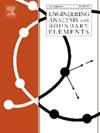A study on different implementations of Neumann boundary conditions in the meshless RBF-FD method for the phase-field modelling of dendrite growth
IF 4.2
2区 工程技术
Q1 ENGINEERING, MULTIDISCIPLINARY
Engineering Analysis with Boundary Elements
Pub Date : 2025-02-14
DOI:10.1016/j.enganabound.2025.106154
引用次数: 0
Abstract
This paper studies and assesses different Neumann boundary conditions (BC) implementations in the radial basis function generated finite difference (RBF-FD) method. We analyse four BC implementations by solving a phase-field model for single dendrite growth in supercooled pure melts. In the first BC implementation, the BC are satisfied when constructing interpolation problems in the local support domains near the boundary. In the second one, the BC are satisfied by solving an additional system of linear equations for the field values in the boundary nodes. In the third one, we add a layer of ghost nodes to the boundary nodes; the BC are satisfied by solving an additional system of linear equations for the field values in the ghost nodes. The fourth BC implementation uses the same node distribution as the third one; since we are dealing with the symmetric BC, we set the values in the ghost nodes by direct mirroring. We analyse the influence of the size of a local support domain and the type of node distribution (regular/scattered) on the accuracy. We show that using ghost nodes is recommended to consider Neumann BC in the RBF-FD method accurately when solving phase-field models for dendritic growth.
枝晶生长相场模拟无网格RBF-FD方法中不同Neumann边界条件实现的研究
研究和评价了径向基函数生成有限差分(RBF-FD)方法中不同的Neumann边界条件(BC)实现。我们通过求解过冷纯熔体中单枝晶生长的相场模型来分析四种BC实现。在第一个BC实现中,当在边界附近的局部支持域中构造插值问题时,BC得到了满足。在第二种方法中,通过求解边界节点上的场值的附加线性方程组来满足BC。在第三种方法中,我们在边界节点上添加了一层幽灵节点;通过求解虚节点中场值的附加线性方程组来满足BC。第四个BC实现使用与第三个相同的节点分布;因为我们处理的是对称BC,所以我们通过直接镜像来设置虚节点中的值。我们分析了局部支持域的大小和节点分布类型(规则/分散)对精度的影响。我们表明,在求解枝晶生长的相场模型时,建议使用虚节点来准确地考虑RBF-FD方法中的Neumann BC。
本文章由计算机程序翻译,如有差异,请以英文原文为准。
求助全文
约1分钟内获得全文
求助全文
来源期刊

Engineering Analysis with Boundary Elements
工程技术-工程:综合
CiteScore
5.50
自引率
18.20%
发文量
368
审稿时长
56 days
期刊介绍:
This journal is specifically dedicated to the dissemination of the latest developments of new engineering analysis techniques using boundary elements and other mesh reduction methods.
Boundary element (BEM) and mesh reduction methods (MRM) are very active areas of research with the techniques being applied to solve increasingly complex problems. The journal stresses the importance of these applications as well as their computational aspects, reliability and robustness.
The main criteria for publication will be the originality of the work being reported, its potential usefulness and applications of the methods to new fields.
In addition to regular issues, the journal publishes a series of special issues dealing with specific areas of current research.
The journal has, for many years, provided a channel of communication between academics and industrial researchers working in mesh reduction methods
Fields Covered:
• Boundary Element Methods (BEM)
• Mesh Reduction Methods (MRM)
• Meshless Methods
• Integral Equations
• Applications of BEM/MRM in Engineering
• Numerical Methods related to BEM/MRM
• Computational Techniques
• Combination of Different Methods
• Advanced Formulations.
 求助内容:
求助内容: 应助结果提醒方式:
应助结果提醒方式:


